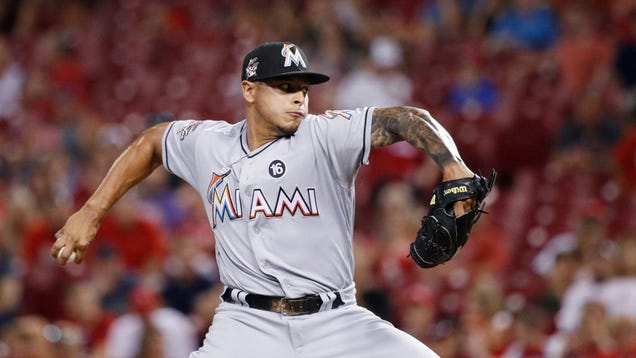
The NL East played a little role-player musical chairs Friday: the Phillies, owners of the worst record in all of baseball, sent outfielder Howie Kendrick to the Nationals for 21-year-old lefty pitching prospect McKenzie Mills; and the Mets, currently 13.5 games back of the Nationals in the division and nine games out of the second NL Wild Card spot, sent a couple of prospects—21-year-old hard-throwing pitcher Merandy Gonzalez and 19-year-old outfielder Ricardo Cespedes—to the Marlins, also currently 13.5 games back of the Nationals in the division and nine games out of the second NL Wild Card spot, for A.J. Ramos, an All-Star reliever.
The Nats-Phillies deal makes sense, according to standard late-summer MLB logic: Mills isn’t all that exciting a prospect—FanGraphs had him outside of Washington’s top 20 prospects back in March—but Kendrick is a 34-year-old surplus outfielder who has only played 39 games in 2017, making him all but worthless on a rebuilding team like the Phillies. Washington’s offense is absurd, but so are their injuries—outfielders Adam Eaton, Jayson Werth, Michael Taylor, Chris Heisey, and Ryan Raburn are all currently out with injuries, leaving them with a gaping opening for an outfielder who can, you know, play. Kendrick is dealing with soreness in his left hand and has missed a lot of time already this season, but the fact that he is not on the DL makes him a precious commodity for the Nats, certainly worth a pitching prospect of little value.
Advertisement
It’s harder to make sense of that Marlins-Mets deal (the New York Post calls it “shocking”). The two teams have the same record; the Mets have the worse run differential of the two; neither team has any sort of realistic chance at making a push for the postseason. The Marlins understood that to mean they should shift into seller mode, shipping David Phelps and now Ramos away in exchange for six minor league prospects. The Mets also seemed to be in seller mode—they traded Lucas Duda for a pitching prospect this week—but it is not typical seller behavior to move prospects for arbitration-eligible relievers. What are the Mets doing?
The Mets aren’t the most injury-ravaged team in baseball this season, but the injuries they’ve had have seemed cruelly designed to cripple their chances at fielding what might have been a playoff-quality roster: Matt Harvey, Zack Wheeler, and Noah Syndergaard have combined to make just 35 starts, and reliever Jeurys Familia made just 11 appearances before an arterial clot in his throwing shoulder put him out indefinitely. That’s at least in theory four of the five most important arms on the team, a loss that goes a long way towards explaining New York’s putrid 4.88 team ERA, second worst in the National League.
Advertisement
It seems like the Mets look at themselves as a team that, if healthy, should be back in the mix in the NL East in 2018, with more use for contributors than prospects, and with an opportunity to stack their bullpen with a formidable Ramos-Familia late-innings tandem. But the timing is funny—prospects nabbed in trades during this down season would presumably make the Mets stronger buyers next season, if, in fact, the returns of Syndergaard and Familia stabilize their pitching and return them to top of the NL East. If, instead, the Mets get off to a lousy start in 2018 and find themselves sellers again next July, they’ll rue the time they might’ve spent stocking the cupboards with talented youngsters positioned to solidify their own future.
Advertisement
Because they are the Mets, you should plan on this thread-the-needle strategy blowing up in their faces. On the other hand, they do have savior Tim Tebow rocketing up their farm system. Help is on the way!
SOURCE - DEADSPIN posted by Campus94Me


No comments:
Post a Comment